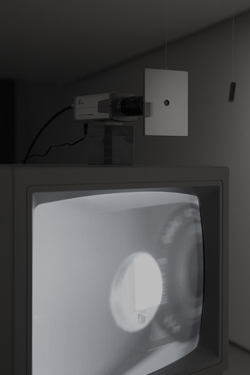Peter Campus' 'Kiva' video installation finds new relevance decades later

A video installation that effortlessly mingles its meaning with its media, "Kiva" consists of swinging mirrors, an ever-ready camera, and an old-school television monitor that reflects the art that resides outside us.
Campus is best known for his pioneering interactive and single-channel video of the early 1970s. His work is widely collected by major museums and galleries including New York City’s Guggenheim Museum; Museum of Modern Art, and Whitney Museum; London’s Tate Modern Museum; Madrid’s Renia Sofia; and Paris’ Centre Pompidou.
“Kiva,” his 1971 video installation, employs a closed-circuit live video feed that reproduces whatever comes into its visual range. But, as the UMMA’s New Media gallery statement tells us, Campus’ interest is not “in surveillance and control, but rather” what he considers “situations of interactive engagement between viewer and image.”
As the statement continues, the installation consists of “a monitor with a closed circuit camera mounted on top; the lens pointed directly at the viewer of the monitor, (with) the camera’s view restricted and manipulated by the placement of suspended mirrors.
“The camera shoots through a hole in one mirror to the surface of the other, both constantly shifting in relation to each other as they turn like a mobile. The mirrors fragment and multiply the image, allowing the camera to take in aspects of the room, the viewer, and the eye of the camera itself.”
The idea of “Kiva,” says Campus, is to put the viewer in a “position of agency.” And it’s indeed this “position of agency” that makes the installation quirkily compelling.
Campus embellished on this definition in a Dec. 2009 Art Review interview when he said, “You walk into the room and at first (“Kiva”) is unapparent. Then, there shortly comes the shock of your own image as you activate the camera.
“I want visitors to explore the room, even the areas out of the camera’s view, because the entire set-up—the space, the camera, even the camera mounts—are intrinsic to them.”
Campus then continues, saying his intent is “to subvert the passive viewer.”
He adds, “over the years I’ve come to privately mock that aim. Is a person watching a movie or viewing a picture really passive? I’ve come to think not. So now I see (“Kiva”) not about passivity/activity; but as raising questions relating to the body.”
Campus’ media in “Kiva” is now relatively old-fashioned. There’s been such an explosion of electronic video presence in our private lives today that seeing ourselves through a video monitor doesn’t have the same shock value “Kiva” might have had in the 1970s.
Instead, it’s “Kiva’s” very anachronism that now raises “questions relating to the body” because the swaying monochromatic view one gets in the monitor is only a partial glimpse of our self.
As such, and as the UMA’s gallery statement notes, it’s this camera shooting “through a hole in one mirror to the surface of the other, both constantly shifting in relation to each other as they turn like a mobile” that generates sustained interest in the installation.
“The mirrors fragment and multiply the image,” concludes the statement, “allowing the camera to take in aspects of the room, the viewer, and the eye of the camera itself.”
“Kiva” upends the sustained self we’ve grown accustomed to seeing in photographs, online, and through video clips.
Campus cunningly undermines this balance. And his installation plays on this upending through its stolid placement in the center of the New Media gallery by toying with our expectation of art—as well as our sense of identity—through its relentless kaleidoscopic broadcast.
“Peter Campus: Kiva” will continue through Aug. 12 at the University of Michigan Museum of Art, 525 S. State St. Museum hours are 10 a.m.-5 p.m. Tuesday-Saturday, and noon to 5 p.m. Sunday. For information, call 734-763-UMMA.


Comments
gravus
Thu, Jul 19, 2012 : 5:31 p.m.
'Kiva' is a native american ceremonial building, often underground. many are in a cylinder shape, and the rotation of the mirrors refer to this shape. this work was made in 1971. two years before i visited many native american sites, and got some of the ideas for the work there. btw the mirrors are specially made front surface mirrors, to have the best optical quality.
Kai Petainen
Sun, Jul 22, 2012 : 7:36 p.m.
sweet... i gotta check it out.
Kai Petainen
Wed, Jul 18, 2012 : 3 a.m.
fun and neat. 'Kiva' in Finnish means... 'fun' or 'neat'